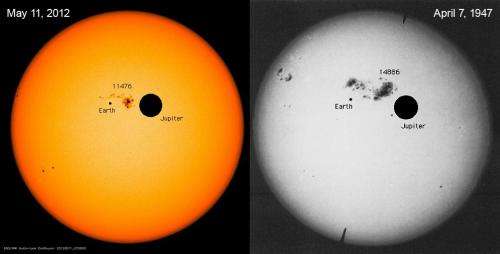How big are sunspots?

The short answer? Really big. The long answer? Really, really big.
The image above shows sunspot regions in comparison with the sizes of Earth and Jupiter, demonstrating the sheer enormity of these solar features.
Sunspots are regions where the Sun’s internal magnetic fields rise up through its surface layers, preventing convection from taking place and creating cooler, optically darker areas. They often occur in pairs or clusters, with individual spots corresponding to the opposite polar ends of magnetic lines.
The image on the left was acquired by NASA’s Solar Dynamics Observatory on May 11, 2012, showing Active Region 11476. The one on the right comes courtesy of the Carnegie Institution of Washington, and shows the largest sunspot ever captured on film, AR 14886. It was nearly the diameter of Jupiter — 88,846 miles (142,984 km)!
“The largest sunspots tend to occur after solar maximum and the larger sunspots tend to last longer as well,” writes SDO project scientist Dean Pesnell on the SDO is GO blog. “As we move through solar maximum in the northern hemisphere and look to the south to pick up the slack there should be plenty of sunspots to watch rotate by SDO.”
Sunspots are associated with solar flares and CMEs, which can send solar storms our way and negatively affect satellite operation and impact communications and sensitive electronics here on Earth. As we approach the peak of the current solar maximum cycle, it’s important to keep an eye — or a Solar Dynamics Observatory! — on the increasing activity of our home star.
Source: Universe Today




















